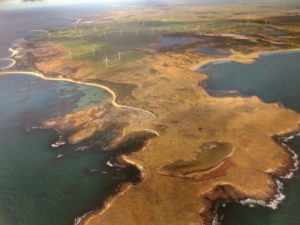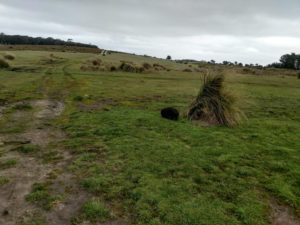In September of 2018, I traveled to Tasmania to volunteer with Wombat Rescue Tasmania, a group working to combat mange. The following article was written about one small part of that trip, and was published in WRT’s newsletter in the winter of 2019.
In May of 2017, a nurse named Kate Nixon called Wombat Rescue Tasmania to report a mangy wombat on the Woolnorth Wind Farm in the Musselroe Bay area. She had been out teaching her son to drive when she spotted the wombat near the visitor’s center.
“How can I get access? thought Bea Maynes, president of WRT. She wondered if perhaps there was someone who cleaned the bathrooms at the wind farm’s visitor’s center, so she called the shop in Gladstone and asked. The woman at the shop gave her Jill Brobert’s name. Jill was easy to reach and said her husband, Dig Brobart, worked on the farm doing maintenance. She let Bea talk to him, and Dig put Bea in touch with Bob Barbour, health and safety advisor for Woolnorth.
So many things might have doomed the effort from the start. Bea might have been unable to find a contact, or unable to find a contact willing to talk with her. Woolnorth might have considered the effort not worth the trouble, or might have rejected help from WRT based on security policy or liability concerns. But Bob was very interested to hear about WRT’s work, so he arranged for a group to come up in late May for a tour. They met in the coffee room and went through a mandatory induction process, learning safety procedures so they could be allowed on the property. They were taken for a tour and shown the inside of a turbine. Then Bob pointed them in the direction of a wombat burrow and left the group to wander around on their own.

They found several mangy wombats right away and began placing burrow flaps. A burrow flap is a homemade contraption placed in front of the entrance to a wombat burrow to dump Cydectin on the wombat’s back as he enters the burrow. From that point on, a group of two or three volunteers, coordinated by Lauren Faulkner, went up to the wind farm every week; no small feat, given that it was a two and a half hour drive each way. Visits were long days for the group of volunteers, who usually left their homes at 6:00 am and didn’t get home until about 6:00 pm.
The treatment visits continued for about seven months, and the group placed approximately 150 burrow flaps in that time. They used the Avenza app to map and track every burrow flap, staying on a 12-week treatment cycle. When summer arrived, along with the snakes, all of the burrows had finished their 12 weeks of treatment and WRT discontinued the visits, hoping to hear feedback on their success.
A year passed. Dig kept Bea and Lauren informed, calling every two or three months to say there had been no new reports of mangy wombats from any of the workers. In August of 2018, he reported that he had seen one or two mangy wombats, although he wasn’t completely sure it wasn’t just a sandy wombat butt.

In September of 2018, I showed up from the U.S. to help out for ten days. After a few days helping the efforts in Kelso, Bea had an idea that we could go up to Woolnorth to check on the treated wombats and it would give me a chance to see a part of Tasmania I hadn’t been to before. We left on a Wednesday afternoon and arrived at Woolnorth around 3:00 in the afternoon. After settling into the stone cottage Woolnorth offers to its contract workers and guests for overnight stays, we headed out on the wind farm’s dirt roads to see what we could find during the remaining daylight hours. We had run into Bob on the road coming in, and he told us there was a young wombat near turbine number B10 that was out during the day and didn’t look healthy, so we headed there first.
We found Bob’s young wombat right away, and he was clearly manged, although he looked to be either early stage or perhaps recovering from treatment. He sat inside a cattle fence, grazing, covered in scabs but still aware enough to be wary of us. I crawled under a fence and followed him to his burrow nearby. We hadn’t brought any burrow flaps with us, but we thought we should at least identify any treatment needs in case the group needed to come back.

We left the mangy juvenile and drove up to an area called the marsh, and there we saw quite a few healthy wombats out grazing. Several times we left the car to take photos, once even making the mistake of getting too close to a mother wombat, who charged at us in defense of her joey. We saw one more wombat with mange, but the majority had beautiful, full, glossy coats.
In the evening, Dig and one of his co-workers came by to take us spotlighting. We spent a magical two hours riding in Dig’s jeep with high-powered spotlights on either side, lighting up hundreds of healthy wombats. We saw brush-tailed possums, kangaroos and wallabies, and even finally a bettong. Dig had perfected an imitation of wombat and possum noises that caused many of animals to stop and stare at us in apparent curiosity.
By my count, at the end of the day we had seen about 200 healthy wombats and only two, possibly three, with mange. The next morning we scrounged up a burrow flap Dig had found for us and put it on the one burrow we had identified, leaving some Cydectin with Dig so he could begin treating it. We were elated at the apparent success of the group’s efforts the year before.

But truth be told, questions remain. Did all the treated wombats recover? Or did many of them die, leaving the area to be re-populated? Were the mangy wombats we saw new cases, or were they recovering from previous treatment and still showing scabs? If they were new cases, would they re-infect the entire population? Was it better to euthanize a couple of wombats to save a large population from the future risk of re-infection? As always, there is too much we don’t know, and a critical need for more government funding and support for further research.


Comments are closed.